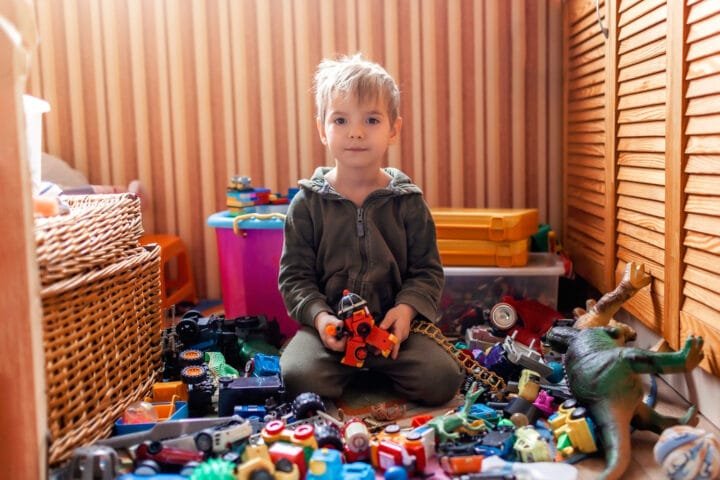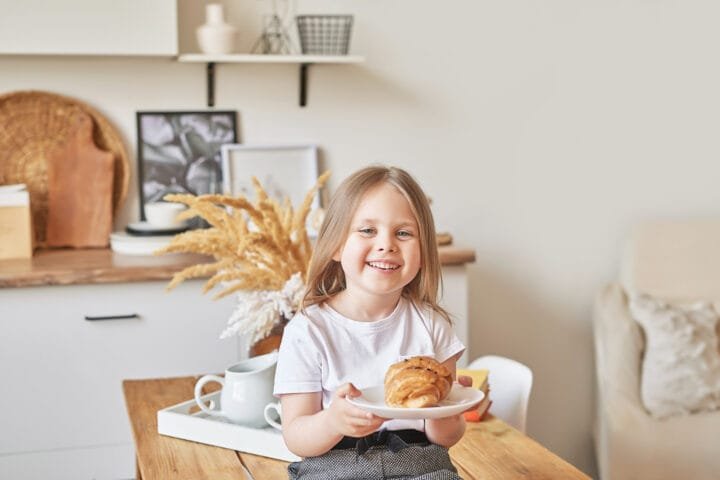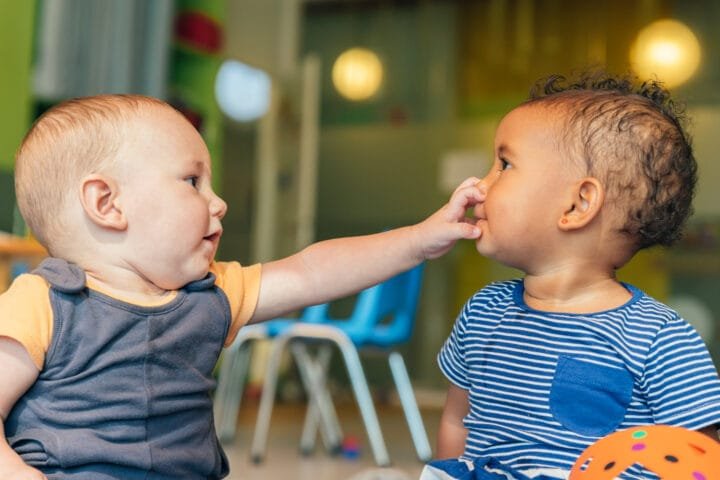Minimalist Parenting: Why Less Toys Might Be the Secret to Raising Happier Kids
Are your kids drowning in stuff they barely touch? Mine were. Three years ago, I stood in the doorway of my daughter’s room, surveying the wreckage of scattered toys, abandoned crafts, and forgotten stuffed animals. That moment changed everything for our family. The avalanche of plastic consuming our home wasn’t just a storage nightmare—it was affecting my children’s behavior, creativity, and even our family’s financial health.
Minimalist parenting isn’t just another trend for Instagram-perfect homes. It’s a revolutionary approach to raising children that challenges our consumer-driven culture. But where’s the line between mindful simplicity and unhealthy deprivation? Let’s dive into this fascinating parenting philosophy that’s changing how families approach childhood development.
The Shocking Truth About Today’s Toy-Saturated Childhood
Today’s average American child owns over 200 toys but plays with only 12 of them daily. Let that sink in. The $28 billion U.S. toy industry keeps churning out more, while studies show children actually play more creatively and focus better with fewer options.
A 2018 study from the University of Toledo found that when toddlers had fewer toys available, they played with each toy longer, discovered more creative ways to use them, and developed deeper concentration. This isn’t just about tidiness—it’s about brain development.
“We’ve created a culture where children expect constant stimulation and novelty,” says child psychologist Dr. Susan Newman. “Then we wonder why they can’t focus on school or entertain themselves without screens.”
When I first discovered minimalist parenting, I wasn’t looking to make some grand philosophical statement. I was simply overwhelmed. Our playroom looked like a toy store after an earthquake. Birthday parties meant anxiety about where we’d put more stuff. Something had to change.
Understanding Minimalist Parenting: Breaking Free from Excessive Consumption
Minimalist parenting exists on a spectrum, not as a one-size-fits-all approach. At its core, it’s about intentionally limiting material possessions to focus on what truly matters for child development and family values.
The history of childhood and possessions is fascinating. Before the post-war consumer boom, most children owned very few toys. A doll, perhaps some blocks, maybe a ball—these simple items sparked imagination for generations. Today’s marketing machine has convinced parents that child development requires specialized toys for every age, skill, and interest.
My neighbor Rosa practices what I’d call moderate minimalism. Her family follows a “one in, one out” rule and rotates toys seasonally. Her kids have enough to play with but not so much they’re overwhelmed. Then there’s my friend James, whose family embraces a more radical approach with just a small basket of open-ended toys for each child.
Both families identify as minimalist parents, but their implementations look quite different. That’s the beauty of this philosophy—it adapts to your family’s unique needs and values.
What distinguishes thoughtful minimalism from neglect? Intention. Minimalist parents deliberately curate their children’s environments to support development and family values. Neglect comes from disregard for a child’s needs. One reduces by choice for specific benefits; the other reduces due to inattention or inability to provide.
The Surprising Brain Benefits of Fewer Toys
Remember that feeling when you walk into a cluttered room and immediately feel anxious? Kids experience that too. A University of Michigan study found that background visual clutter significantly reduced children’s ability to focus and process information.
When my son was five, we reduced his toy collection by about 75%. Within weeks, his teachers commented on his improved attention span. Coincidence? Science suggests otherwise.
Dr. Kim John Payne, author of “Simplicity Parenting,” documented remarkable changes in children with attention disorders when their environments were simplified. In his clinical study, 68% of these children showed significant improvement in symptoms when their toys and belongings were reduced by at least half.
Here’s what happens in the developing brain when we reduce toy overload:
- Increased attention span: Children learn to focus deeper on one activity.
- Enhanced creativity: With fewer ready-made solutions, kids invent their own play scenarios.
- Improved executive function: Children develop better planning and decision-making skills when not overwhelmed by choices.
- Reduced stress: Visual clutter raises cortisol levels—even in kids!
- Better social skills: Without flashy toys dominating play, children focus more on interactions.
I watched this unfold with my own daughter. The child who once flitted from a toy now spends hours creating elaborate worlds with just a few wooden blocks and figurines. Her imagination flourishes in the space we created by removing the excess.
Conscious Consumption: Redefining “Enough” in a More-Is-Better World
Shifting to minimalist parenting requires rethinking what children truly need. Quality over quantity becomes the mantra. One well-made wooden train set that lasts for years and grows with your child is worth dozens of plastic toys that break within weeks.
The most significant challenge? Managing the constant influx. Between doting grandparents, birthday parties, and holiday traditions, the stuff keeps coming. Establishing boundaries requires courage and clear communication.
When we told our parents about our new approach, my mother-in-law was initially hurt. “But I love giving the kids presents!” she protested. We gently explained that we valued her generosity but suggested experience gifts instead—museum memberships, cooking classes, special outings with grandma. Now she’s our biggest supporter, treasuring the memory-making more than the shopping.
According to consumer psychologist Dr. Melissa Weinberg, “Children don’t inherently want mountains of toys. They learn to expect them through marketing and adult behavior. When families shift focus to experiences and meaningful connections, children quickly adapt and often prefer this approach.”
This resonates deeply with my experience. Last Christmas, instead of the usual present mountain, we gave each child three thoughtful gifts plus a family vacation. My nine-year-old later told me, “This was the best Christmas ever, Mom. I remember everything I got, and I use it all!”
The Dark Side: When Minimalism Goes Too Far
While the benefits of thoughtful reduction are clear, it’s crucial to acknowledge potential pitfalls. Some parents, intoxicated by decluttering success, take minimalism to unhealthy extremes.
Child development specialist Dr. Eleanor Thompson warns, “Children need some variety of play experiences. Extreme minimalism—where children have access to just a handful of items—can potentially limit certain developmental opportunities.”
I’ve witnessed this in action. A mom in my community parenting group became so devoted to minimalism that her preschooler had access to only five toys at any time. The child became possessive and anxious about sharing during playdates, clinging desperately to her few precious items.
Another risk is imposing adult aesthetic preferences at the expense of childhood needs. Those gorgeous monochrome playrooms on Pinterest might satisfy a parent’s desire for visual calm but may not provide the sensory stimulation developing brains need.
The key is balance. Minimalism should serve the child’s development, not a parent’s ideology or social media image.
Finding Your Family’s Minimalist Sweet Spot
Every family’s version of minimalism will look different based on living space, number of children, interests, and values. The Johnsons, a homeschooling family of five in a small apartment, maintain strict limits on possessions out of necessity. The Wilsons, with one child in a spacious suburban home, practice a more relaxed approach while still embracing core minimalist principles.
How do you find your family’s balance point? Start by asking these questions:
- What values do we want to emphasize in our family?
- What kinds of play seem most beneficial for each child’s development?
- What causes stress in our current environment?
- Which possessions truly enhance our lives versus creating maintenance work?
For us, the sweet spot emerged through trial and error. We began by removing obvious clutters, the broken toys, the never-used gifts, the duplicates. Then we observed how our children played, and which items sparked genuine engagement.
My daughter thrives with creative materials, so we maintained a well-organized art station while reducing her stuffed animal collection. My son gravitates toward building and physical play, so we kept quality construction toys while letting go of electronic gadgets that seemed to make him irritable.
Practical Implementation: From Overwhelm to Intentional Simplicity
Ready to explore minimalist parenting? Here’s how to begin without traumatizing your kids or causing family rebellion:
Start with a toy inventory. Most parents are shocked to discover just how many toys have accumulated. One weekend, we sorted every toy into categories—building toys, vehicles, dolls, art supplies, etc. The visual impact was stunning. Fifteen stuffed pandas? Twenty-three incomplete puzzles? No wonder our kids couldn’t focus!
Next, involve children in the process—appropriately for their age. We never purged our children’s belongings without their input. Instead, we asked questions like, “You have so many stuffed animals that none get much attention. Should we keep your special favorites and share the rest with children who don’t have many toys?”
Kids often surprise you with their generosity when they understand the purpose. My son, initially reluctant, became enthusiastic about donating toys after we visited a family shelter. “Some kids don’t have ANY toys, Mom,” he said, wide-eyed. He returned home and filled in three donation boxes.
Implement systems that maintain simplicity. Toy rotation works wonders—store most toys out of sight and swap collections every few weeks. Children rediscover their possessions with fresh enthusiasm. We use clear bins in our basement storage area, labeling them with photos for easy identification.
Establish guidelines for new acquisitions. Our family follows the “one in, one out” rule and a waiting period for non-essential purchases. When my daughter wanted a new doll, we instituted a two-week waiting period. By day four, she’d forgotten about it completely.
Communicating Your Choice: Dealing with Gift-Giving Occasions
The hardest part of minimalist parenting? Other people. Well-meaning relatives, birthday party invitations that request “no gift cards, please—bring a wrapped toy!” and cultural expectations create constant pressure to accumulate.
We found success with positive, proactive communication. Before birthdays and holidays, I email family with specific suggestions: “Emma would love a contribution toward swimming lessons,” or “Jake is collecting books about dinosaurs.” Most relatives appreciate the guidance.
For birthday parties, we’ve started suggesting group gifts (“Several families could contribute toward a quality bicycle”) or experience presents (“Gift certificates for ice cream outings are always welcome!”). Some parents initially resist but usually come around when they see the benefits.
When facing pushbacks, focus on the positive benefits rather than criticizing consumerism. Instead of saying, “We don’t want more plastic junk,” try, “We’re creating more space for imagination and outdoor adventures.”
The Surprising Financial Impact of Minimalist Parenting
The average American family spends over $6,500 on child-related purchases during the first year of life alone. Toys, clothing, gear, and gadgets continue to drain bank accounts throughout childhood. Minimalist parenting naturally reduces these costs.
Since embracing minimalism, our family’s discretionary spending has decreased by nearly 40%. That money now funds experiences and investments—a family camping trips, swimming lessons, contributions to college funds.
Beyond immediate savings, minimalist parenting teaches financial literacy. Children learn that happiness doesn’t require constant purchasing. They develop patience, saving for items they truly value rather than demanding immediate gratification.
My daughter recently saved her allowance for eight weeks to buy a quality art set. The pride in her achievement far outweighed any momentary thrill from an impulse purchase. She treats those art supplies with reverence, carefully cleaning brushes and replacing caps—lessons in responsibility no impulse-bought toy could teach.
Research: What Science Says About Stuff and Child Development
The evidence supporting minimalist approaches continues to grow. A 2020 study published in Infant Behavior and Development found that toddlers engaged in more creative, focused play with fewer toys available. Children with access to just four toys played twice as long with each item compared to those surrounded by sixteen options.
Developmental psychologist Dr. Marsha Davidson explains, “Children need some novelty for brain development, but they also need simplicity to process information effectively. The constant novelty of numerous toys can create overstimulation that actually impedes learning.”
Environmental psychologists have also identified connections between physical clutter and mental health. A 2017 study from Cornell University found that children in cluttered home environments showed elevated stress hormones compared to those in more organized spaces.
Perhaps the most compelling are longitudinal studies on materialism. Children raised with strong emphasis on possessions show higher rates of adult anxiety, depression, and relationship difficulties. They also report lower life satisfaction. In contrast, children raised with emphasis on experiences and relationships tend to become more well-adjusted adults.
Beyond Toys: Minimalist Principles in Other Aspects of Parenting
Minimalist parenting extends beyond toy management. The core philosophy—intentionally reducing excess to focus on what matters most—applies to multiple parenting domains:
Schedules: Many families find themselves overcommitted to activities, leaving little time for unstructured play or family connection. Minimalist parents carefully curate commitments, ensuring adequate downtime. We limit our children to one structured activity per season, leaving room for spontaneous neighborhood play and family time.
Media: Digital minimalism reduces screen time in favor of real-world experiences. This doesn’t mean banning technology but using it purposefully rather than as a default entertainment source. Our family designates screen-free days each week, and the initial complaints have been transformed into creative alternatives.
Clothing: Capsule wardrobes with versatile, quality pieces reduce morning fatigue and overwhelm laundry. My children each have about 10 everyday outfits per season, plus special occasion clothes. Getting dressed is simpler, and they wear everything they own.
Food: Meal simplification reduces decision fatigue and food waste. We rotate through about 15 family-favorite meals rather than constantly seeking novelty. This approach saves mental energy, grocery money, and reduces the “I don’t like this” battles.
Adapting Minimalism Through Developmental Stages
Effective minimalist parenting evolves as children grow. Toddlers benefit from very simple environments with few distractions, while teenagers need different considerations.
For babies and toddlers, focus on open-ended basic blocks, nesting toys, simple dolls, and books. Limit electronic toys that do the playing for the child. During this stage, we maintained just one small basket of toys in our living room, rotating contents weekly.
School-aged children develop specific interests requiring more specialized items. Support these passions with quality tools rather than quantity. My son’s interest in birds led us to invest in good binoculars and field guides rather than bird-themed everything.
Teenagers need support for identity development, which sometimes involves material experimentation. Our minimalist teen neighbor negotiated with her parents to have flexibility with her clothing choices while maintaining minimalism in her room and activities.
Sustaining Minimalism: When the Novelty Wears Off
The initial decluttering feels revolutionary, but maintaining minimalism requires systems and continued commitment. Many families experience “minimalism backsliding” as old habits resurface.
We combat this through regular reassessment. Every season, we evaluate our possessions against our values and needs. Has something stopped serving us? Has a new interest emerged that requires different tools? This keeps minimalism relevant rather than rigid.
Creating family buy-ins remain crucial for long-term success. Children need to experience the benefits firsthand. We regularly discuss how our home feels calmer, how we have more time for adventures because we’re not constantly cleaning up, and how special toys remain special because they’re not lost in clutter.
Measuring success goes beyond counting possessions. The true metrics are quality of play, family atmosphere, and children’s developing relationship with material goods. Are your children playing creatively? Do they value and care for their possessions? Do they understand the difference between wants and needs? These indicators matter more than achieving some arbitrary item count.
Minimalist Parenting Across Different Cultural Contexts
Western consumerism isn’t universal. Many cultures naturally practice what Americans might label “minimalist parenting.” In Japan, children traditionally had few possessions but deep connection to nature and community. Nordic countries emphasize outdoor play regardless of weather, reducing reliance on indoor entertainment.
Economic necessity drives minimalism in many regions. A Guatemalan friend describes her childhood with just a few treasured toys but rich in family traditions and natural exploration. Her children, now growing up in America, have more possessions but less freedom and connection to nature.
Even within American society, minimalist parenting looks different based on socioeconomic factors, housing situations, and cultural backgrounds. Urban minimalists might focus on space efficiency in small apartments. Rural minimalists might emphasize self-sufficiency skills over commercial toys.
The core principles—intentionality, quality over quantity, and valuing experiences over possessions—translate across contexts while implementations vary widely.
The Ultimate Question: Does Minimalist Parenting Actually Work?
After three years of minimalist parenting, I can share our family’s results. My children fight less, play more creatively, and show greater appreciation for what they have. Our home feels peaceful rather than chaotic. Mornings run smoother without clutter-induced distraction. We save money and time previously spent maintaining excess possessions.
But these benefits didn’t arrive without challenges. We’ve weathered grandparent disappointment, birthday party awkwardness, and occasional child resistance. We’ve made mistakes, sometimes cutting too deeply or holding too firmly principles over people.
The key to success has been flexibility and focus on underlying values rather than strict rules. We aim for progress, not perfection. Some seasons call for more stuff—like when my son broke his leg and needed indoor activities during recovery. Other times, we naturally pare down further.
Dr. Thomas Harrison, family therapist and parenting researcher, suggests, “The most successful minimalist families maintain focus on abundance rather than deprivation. They emphasize all they gain through simplicity—time, connection, creativity—rather than what they give up.”
This perspective shift makes all the difference. We’re not taking from our children; we’re giving them something invaluable, the space to develop without the burden of excess.
Your Minimalist Parenting Journey: Starting Small for Big Impact
If minimalist parenting intrigues you, start with one small area rather than attempting a complete lifestyle overhaul. Perhaps begin with the playroom, implementing toy rotation. Or simplify mealtime options for less decision fatigue. Small successes build confidence for bigger changes.
Watch carefully how your specific children respond. Some thrive immediately with fewer distractions. Others need more gradual transitions or different minimalist interpretations. Your seven-year-old artist might legitimately need more art supplies than the average minimalist blog recommends. That’s perfectly fine.
Remember that minimalist parenting isn’t about creating Instagram-worthy monochrome playrooms. It’s about intentionally creating space—physical and mental—for your children to develop their unique gifts without the burden of excess.
Three years ago, standing in my daughter’s toy-strewn room, I never imagined how profoundly a shift toward less stuff would improve our family life. The journey hasn’t always been easy, but watching my children flourish in their simplified environment makes every difficult conversation and donation bag worthwhile.
Less really can be more when it comes to raising resilient, creative, and content children. The space you create by removing excess becomes filled with something far more valuable—connection, creativity, and childhood wonder.
FAQs
Minimalist parenting is an approach that promotes simplicity and intentionality in raising children. It focuses on reducing physical and mental clutter, prioritizing quality over quantity, and encouraging children to explore their own interests. Rather than constantly buying new toys or participating in endless activities, minimalist parenting emphasizes meaningful experiences and values over material possessions.
Minimalist parenting offers numerous benefits, including reduced stress for the entire family, fewer child meltdowns, more meaningful family time, and significant financial savings. Children raised with minimalist principles often develop better focus, increased creativity, greater independence, and a deeper appreciation for what they have. This parenting style also teaches important values like gratitude, mindfulness, and environmental responsibility.
Begin by decluttering your children’s spaces, keeping only toys and items that truly engage them. Implement systems like toy rotation or the one-in-one-out rule. Focus on buying fewer but higher quality items, and prioritize experiences over material goods. Reduce overscheduling by selecting activities thoughtfully based on your child’s genuine interests. Remember that minimalist parenting is a journey—start with small changes and gradually build toward a simpler, more intentional family life.
Have open, honest conversations with family members about your minimalist parenting values. Suggest alternative gift ideas like experience gifts (museum memberships, classes, trips), consumable items, or contributions to education funds. For grandparents who love giving physical presents, consider keeping a wish list of quality items your child actually needs or establishing special traditions around fewer, more meaningful gifts. Set clear boundaries while acknowledging others’ desire to show love through giving.
Minimalist parenting isn’t about depriving children but rather about being intentional with what you bring into their lives. By reducing excess and unnecessary items, you create more space for meaningful experiences, creativity, and deeper connections. Children with fewer toys often play more deeply and imaginatively with what they have. The approach focuses on providing quality experiences and possessions that align with your family’s values, rather than simply accumulating more stuff.
Top 5 Minimalist Parenting Books
This practical guide teaches busy parents how to embrace the core principles of minimalism in their daily family life. Perfect for those looking to thrive with less, this book approaches minimalism not as a distant goal but as an ongoing lifestyle that brings inner calm and focuses on what truly matters.
Kim John Payne’s influential book explains how simplifying your home environment, establishing rhythms and schedules, scaling back on media, and filtering out adult concerns can help children thrive. This research-backed approach shows how reducing the overwhelming aspects of modern childhood creates space for deeper connections and development.
Sarah Ockwell-Smith’s comprehensive guide covers gentle parenting principles from infancy through the teenage years. While focused on empathetic discipline, this book aligns perfectly with minimalist principles by emphasizing quality connection over material possessions and offering practical advice on creating nurturing environments with fewer distractions.
Christine Koh and Asha Dornfest provide a framework for identifying what matters most to your family and creating space for those priorities by eliminating the unnecessary. This book gives parents permission to opt out of the more-is-better culture and focus on quality over quantity in all aspects of family life.
Dr. Laura Markham’s approach to parenting emphasizes emotional regulation and connection as the foundation for a harmonious home. This book complements minimalist parenting perfectly by focusing on relationship-building rather than material solutions to parenting challenges.















































































